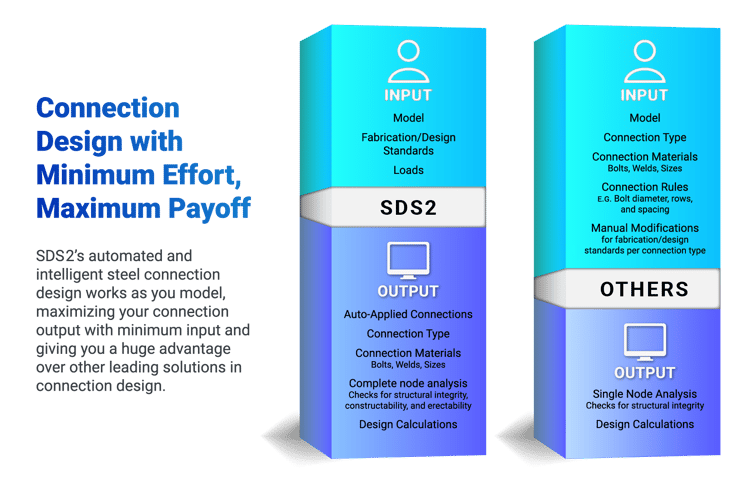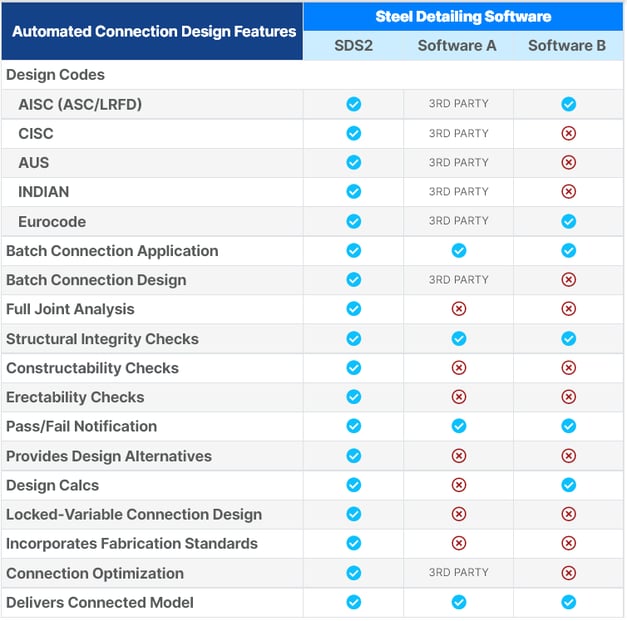SDS2 is the most intelligent and automated—in short, the best—steel connection design software on the market today.
But what makes our software intelligent? How does our automation work? And, most importantly, what does that mean for you? Because that’s what really matters here—your user experience, your results, and your decision.
Simply put, SDS2 connection intelligence is designed to minimize your input and maximize your output.
What you put into the software for each connection are the details: your model, your loads, your fabrication and design standards. And that’s it.
What you get, in a matter of seconds, are fully designed steel connections that satisfy the framing conditions of the entire node or joint and are validated by extended design calculations.
And what that ultimately means for you is more time, fewer errors and RFIs, more economical and labor-efficient designs, and—have we mentioned this one yet?—more time. Free time, family time, nap time, time to get through more projects so you can afford more vacation time.

How does other software stack up?
This input/output trade-off looks markedly different in other leading connection design solutions, where your input generally includes your connection type (applied individually to each node in your model); connection material, including rows of bolts, material size, welds, etc.; additional connection rules, such as bolt diameter, rows, and spacing; and any manual modifications needed to meet fabrication preferences.
In other words, you have to do the detailing and all the connection design work. And your output? A basic structural analysis of the connection, and some design calculations.
Where SDS2 analyzes the complete node, factoring in clash detection and other potential errors in fabrication and erection, other leading solutions provide only single node analysis, telling you if the connection meets basic structural requirements.
If your connection fails, you have to manually adjust dimensions on the connection material and run the analysis again until you get it right.
And if you do all of this and then make a change to a member in your model, you’ll likely have to go through the whole process all over again.
Compare this to SDS2, where connections are automatically designed as you import or input your model and automatically adjusted whenever you make changes. Again, in a matter of seconds.
(The other real kicker here is that with the leading competitor in steel detailing software, most of this work is done in a third-party program, with data imports and exports between the model and the connection design software—but we’ll save that discussion for another time).
Steel Connection Design in SDS2 vs. Other Detailing Software

How does our automated connection design work?
The automation for SDS2’s connection design begins with your—or rather, your fabricator’s—preferences. When you begin a project, you’re given the option to control various setup options to define things like angle sizes, plate thicknesses, a schedule of minimums for bolt rows, and numerous other specifications meant to optimize fabrication for the designated shop.
Then, as you are inputting your model and setting up various framing conditions, SDS2 runs its back-end calculations—factoring in your setup preferences—to automatically add a passing connection to your model.
And when we say passing, we’re not just talking about structural integrity. As mentioned earlier, the math behind our connections analyzes the complete node, looking at every member coming in as well as connections on the other angles and adjusting for potential conflicts that would impact fabrication and field fit-up. It’s a next-level reality check, above and beyond any other steel connection design solution out there.
Of course, we realize that the automatic solution may not work for every connection in your model. You can always override the automation. We provide user-friendly control settings for just that purpose, and here you can see another SDS2 difference.
In other solutions, you define your connection specifications and dimensions and check to see if you’re meeting the load requirements. In SDS2, you start with the load requirements—your end goal—and SDS2 provides the supporting variables.
With our patented locked variable connection design, you can maintain control of the variables most important to your fabricator—plate thickness, rows of bolts, or weld size, for example—and SDS2 will fill in the remaining values to meet your required limit states.
It’s the perfect combination of intelligent automation and user-oriented control.
Ready to get started?
Schedule a demo today to see SDS2's connection design in action and learn how it can benefit your business.
